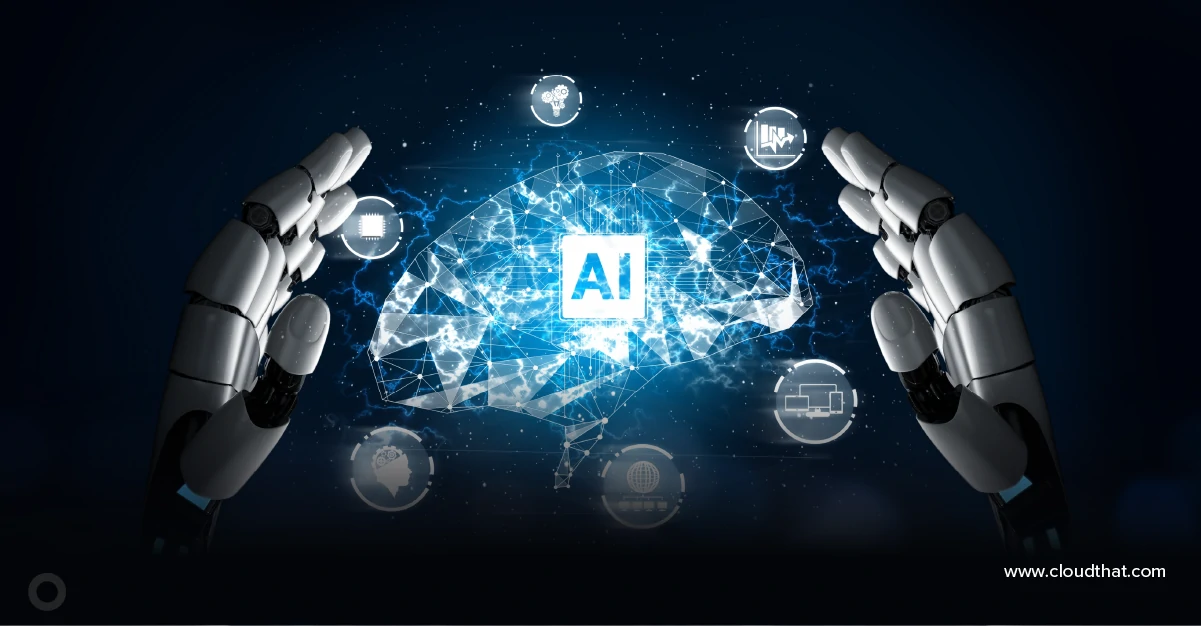|
Voiced by Amazon Polly |
Multi-Modal AI
Multi-Modal AI refers to AI models that can understand and generate content using more than one type of input. These types of data, known as modalities, include:
- Text (e.g., a user query or description)
- Images (e.g., photographs or diagrams)
- Audio (e.g., speech or music)
- Video (e.g., recorded events or tutorials)
- Structured data or code (in specialized systems)
For example, a multi-modal system might accept an image and a question like, “What is this animal doing?” and generate a meaningful response such as, “The dog is jumping into a pool.” Other systems can create images from text, summarize video content, or answer spoken questions based on documents and visuals.
This ability to reason across modalities marks a significant shift from earlier AI models that specialized in one domain, such as text-only chatbots or image classifiers.
Pioneers in Cloud Consulting & Migration Services
- Reduced infrastructural costs
- Accelerated application deployment
Why Multi-Modal AI Matters?
Multi-modal AI enables systems to interact more naturally and usefully, much like humans do. We rarely use just one kind of input to understand something, we read, watch, listen, and talk, often all at once. Multi-modal systems are designed to mirror this versatility.
Key benefits include:
- More powerful assistants that understand images and documents, not just text commands.
- Advanced content creation, such as turning a prompt into a full video or presentation.
- Better contextual understanding in education, healthcare, and customer service applications.
These capabilities are already being integrated into tools used in daily work, from document intelligence platforms to intelligent meeting assistants that can summarize conversations with visuals.
Core Architecture and Techniques
While the underlying models can be complex, the idea behind multi-modal AI is a straightforward process in which each input type is processed effectively and combined to understand their relationships.
Here’s how it generally works:
- Encoding Each Modality
Text, images, and other inputs are first passed through specialized encoders. These are neural networks trained to extract meaningful features from that specific data type. - Creating a Shared Representation
The outputs from these encoders are transformed into a standard format, often called an embedding space. This allows the model to “compare” a sentence and an image, or link a spoken phrase to a video scene. - Cross-Modality Learning
During training, the model is shown related examples, such as a caption and its image, and learns how the inputs align. Techniques like contrastive learning help the model distinguish between related and unrelated pairs. - Unified Transformer Models
Most modern multi-modal systems now use variants of the Transformer architecture. These models are adapted to handle sequences from different modalities, allowing for tasks like answering questions about a diagram or generating visuals from prompts.
This shared framework powers systems like GPT-4o, Gemini, and others to process and reason across complex, mixed-media inputs.
Recent Developments in 2025
Several major players in AI are rapidly expanding their multi-modal capabilities:
OpenAI’s GPT-4o (“Omni”):
GPT-4o, released in May 2025, is OpenAI’s first natively multi-modal model. It can simultaneously handle text, images, audio, and code, with fast response times suitable for real-time applications like AI agents and tutoring systems.
Google’s Gemini 1.5 Pro:
Gemini models are tightly integrated with Google services and can process long-context information across images, documents, and videos. They feature memory across sessions, which is useful in productivity and research tasks.
Meta’s ImageBind and Audiocraft:
Meta has developed research models that align audio, image, depth, and other sensory data in a shared space, opening up new possibilities in virtual reality and multi-sensory AI.
Cloud Providers and Multi-Modal AI
AWS (Amazon Web Services):
Amazon Bedrock: Hosts foundation models from companies like Meta, Anthropic, Stability AI, and Amazon’s own Titan models, many of which support image and text generation.
SageMaker JumpStart offers prebuilt multi-modal models and training templates using PyTorch, TensorFlow, and Hugging Face, making it easier to fine-tune or deploy these models on AWS infrastructure.
Microsoft Azure:
Azure OpenAI Service: This service gives enterprises access to OpenAI’s GPT-4o and DALL·E models, enabling integration into Azure-based applications like Microsoft Copilot.
Azure AI Vision: Provides APIs for combining OCR, document analysis, image tagging, and language understanding, supporting practical multi-modal use cases like form processing and image-based search.
Google Cloud:
Vertex AI supports the training and deploying Gemini models and multimodal pipelines with long-context inputs. It is integrated with Google Workspace and YouTube, making it suitable for education, media, and enterprise search.
What Freshers Should Focus On?
Understanding multi-modal systems is increasingly valuable when entering the AI or cloud domain. Here’s where to begin:
- Programming & Tools:
- Learn Python and gain experience with deep learning libraries like PyTorch.
- Familiarize yourself with cloud services (AWS SageMaker, Azure ML, or Vertex AI).
- Projects & APIs:
- Explore pre-trained models on Hugging Face (e.g., BLIP, CLIP, LLaVA).
- Try hands-on projects like image captioning, document Q&A, or building a chatbot that responds to images.
- Core Concepts:
- Learn the basics of Transformer models, embeddings, and sequence modeling.
- Understand all different data types, their encoding and integration into unified systems.
By building foundational skills now, you will be prepared to contribute to or even build the next generation of intelligent, multi-modal applications.
Conclusion
Drop a query if you have any questions regarding Multi-modal AI and we will get back to you quickly.
Empowering organizations to become ‘data driven’ enterprises with our Cloud experts.
- Reduced infrastructure costs
- Timely data-driven decisions
About CloudThat
CloudThat is an award-winning company and the first in India to offer cloud training and consulting services worldwide. As a Microsoft Solutions Partner, AWS Advanced Tier Training Partner, and Google Cloud Platform Partner, CloudThat has empowered over 850,000 professionals through 600+ cloud certifications winning global recognition for its training excellence including 20 MCT Trainers in Microsoft’s Global Top 100 and an impressive 12 awards in the last 8 years. CloudThat specializes in Cloud Migration, Data Platforms, DevOps, IoT, and cutting-edge technologies like Gen AI & AI/ML. It has delivered over 500 consulting projects for 250+ organizations in 30+ countries as it continues to empower professionals and enterprises to thrive in the digital-first world.
FAQs
1. How is multi-modal AI different from traditional machine learning models?
ANS: – Traditional models typically handle one kind of data, like text or images. Multi-modal models are designed to combine and relate different data types, making them capable of more complex and flexible reasoning.
2. Can I work with multi-modal AI without advanced degrees?
ANS: – Yes. Many tools, such as Hugging Face, OpenAI API, and cloud-based platforms, allow developers to use and fine-tune multi-modal models without requiring advanced research expertise. Strong fundamentals in coding and applied machine learning are sufficient to get started.

WRITTEN BY Niti Aggarwal


 Login
Login


 June 25, 2025
June 25, 2025 PREV
PREV










Comments